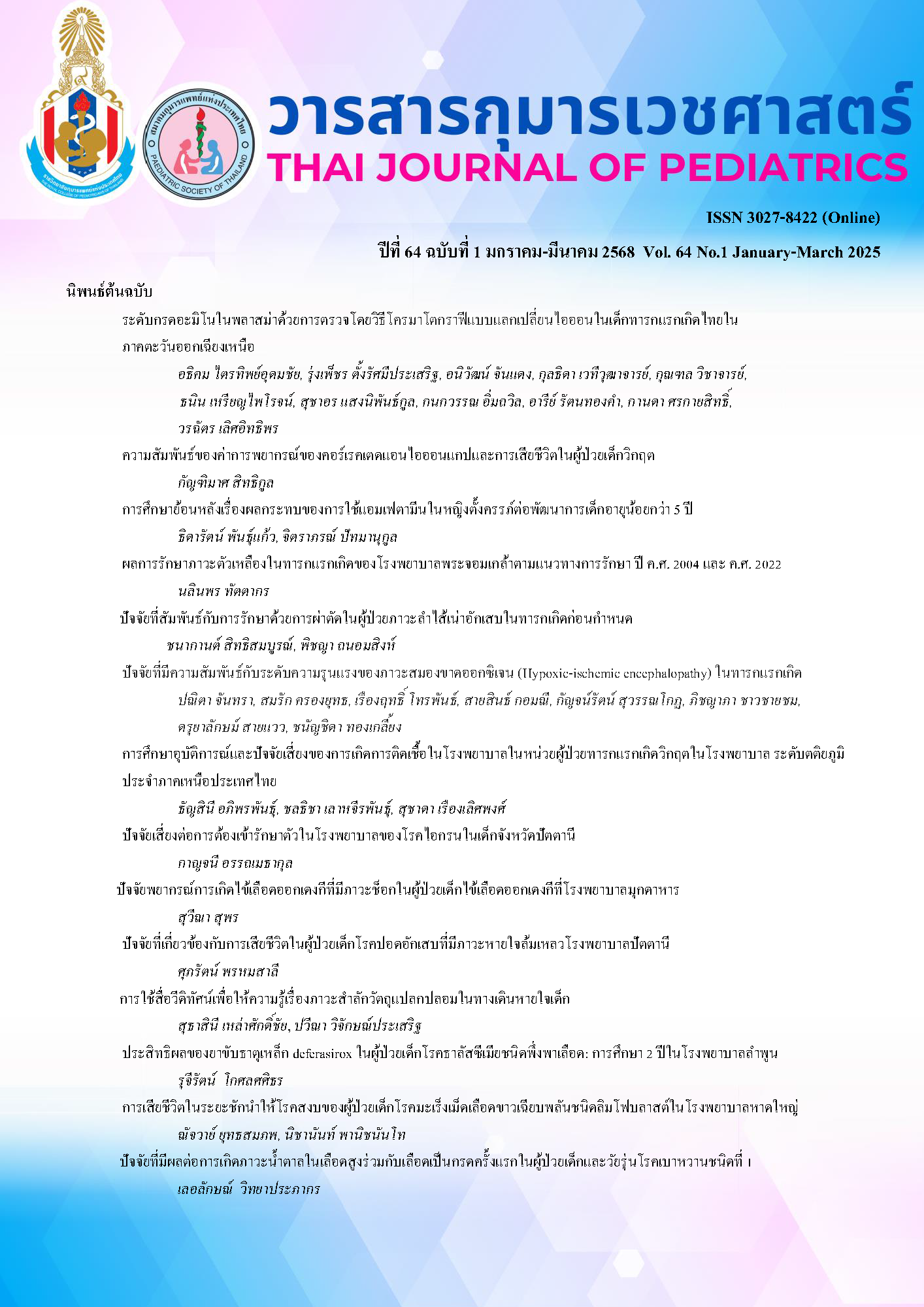Association between corrected anion gap and mortality in pediatric critical illness
Keywords:
corrected anion gap, , anion gap, mortality, predictive value, pediatric intensive care unitAbstract
Background: The predictor for mortality in pediatric intensive care units (PICU) is crucial for improving the outcomes of patients. Corrected anion gap is traditionally a biomarker and simple to perform. It has been used as a predictive factor in critically ill adult patients. However, there is a lack of data related to pediatric patients.
Objectives: To investigate the association between corrected anion gap and mortality.
Methods: This observational study was conducted among children aged between 1 month and 15 years admitted to the PICU at Queen Sirikit National Institute of Child Health. Baseline characteristics and medical comorbidities were reviewed. Laboratory variables (pH, base excess, electrolyte, albumin, anion gap, corrected anion gap, and lactate) were measured at the time of admission.
Results: A total of 235 patients with a median age of 25 months were enrolled. The mortality rate was 3.8%. Patients were divided into the survivor and non-survivor groups. Age, gender, reason for admission, and comorbidities were not different between the two groups. The non-survivor group had a significantly higher PRISM III score (p value 0.023), corrected anion gap (p value 0.009), and lactate levels (p value 0.001).
In multivariate analysis, there was no association between the corrected anion gap and mortality.
Conclusions: The corrected anion gap was higher in the non-survivor group but had no significant correlation with mortality.
Downloads
References
Solomon LJ, Naidoo KD, Appel I, Doedens LG, Green RJ, Long MA, et al. Pediatric index of mortality 3 an evaluation of function among ICUs in South Africa. Pediatr Crit Care Med. 2021;22:813–21.
Rashma R, Remya S, Jayakumar C, Shanavas M, Manu R, Remya R. Mortality profile of children admitted to intensive care unit of a tertiary care hospital in Kerala, South India. Int J Med Clin Sci. 2018;1:13–6.
Humoodi MO, Aldabbagh MA, Salem MM, Al Talhi YM, Osman SM, Bakhsh M, et al. Epidemiology of pediatric sepsis in the pediatric intensive care unit of King Abdulaziz Medical City, Jeddah, Saudi Arabia. BMC Pediatr. 2021;21:1–6.
Figge J, Jabor A, Kazda A, Fencl V. Anion gap and hypoalbuminemia. Crit Care Med. 1998;26:1807-10.
Hatherill M, Sajjanhar T, Tibby SM, Durward A, Murdoch IA. Correction of the anion gap for albumin in order to detect occult tissue anions in shock. Arch Dis Child. 2002;87:526–9.
Chawla LS, Shih S, Davison D, Junker C, Seneff MG. Anion gap, anion gap corrected for albumin, base deficit and unmeasured anions in critically ill patients: implications on the assessment of metabolic acidosis and the diagnosis of hyperlactatemia. BMC Emerg Med. 2008;16:8:18.
Balakrishnan I, Crook P, Morris R, Gillespie SH. Early predictors of mortality in pneumococcal bacteraemia. J Infect. 2000;40:256-61.
Sahu A, Cooper HA, Panza JA. The initial anion gap is a predictor of mortality in acute myocardial infarction. Coron Artery Dis. 2006;17:409-12.
Kim MJ, Kim YH, Sol IS, Kim SY, Kim JD, Kim HY, et al. Serum anion gap at admission as a predictor of mortality in the pediatric intensive care unit. Sci Rep. 2017;7:1456.
Kaplan LJ, Kellum JA. Initial pH, base deficit, lactate, anion gap, strong ion difference, and strong ion gap predict outcome from major vascular injury. Crit Care Med. 2004;32:1120-4.
Dubey A, Acharya S, Kumar S, Shukla S, Mahajan S, Bawankule S, et al. Anion gap (AG) or serum lactate-in search of a better prognostic marker in sepsis a cross-sectional study in a rural tertiary care hospital. F1000Research. 2023;12:536.
Zhu Y, He Z, Jin Y, Zhu S, Xu W, Li B, et al. Serum anion gap level predicts all-cause mortality in septic patients: a retrospective study based on the MIMIC III database. J Int Care Med. 2023; 38:349-57.
Chen X, Yang Q, Gao L, Chen W, Gao X, Li Y, et al. Association between serum anion gap and mortality in critically ill patients with COPD in ICU: Data from the MIMIC IV database. Int J Chron Obstruct Pulmon Dis. 2024;19:579-87.
Zemlin AE, Sigwadhi LN, Wiese OJ, Jalavu TP, Chapanduka ZC, Allwood BW, et al. COVID-19 Research Response Collaboration, the association between acid-base status and clinical outcome in critically ill COVID-19 patients admitted to intensive care unit with an emphasis on high anion gap metabolic acidosis. Ann Clin Biochem. 2023;6:86-91.
Wang S, Teng H, Han H, Xu Y. The relationship between albumin corrected anion gap levels and mortality in patients with asthma in the ICU. Sci Rep. 2023;13:16903.
Zhong L, Xie B, Ji XW, Yang XH. The association between albumin corrected anion gap and ICU mortality in acute kidney injury patients requiring continuous renal replacement therapy. Intern Emerg Med. 2022;17:2315-22.
Liu X, Feng Y, Zhu X, Shi Y, Lin M, Song X, et al. Serum anion gap at admission predicts all-cause mortality in critically ill patients with cerebral infarction: Evidence from the MIMIC-III database. Biomarkers. 2020;25:725-32.
Gong F, Zhou Q, Gui C, Huang S, Qin Z. The relationship between the serum anion gap and all-cause mortality in acute pancreatitis: an analysis of the MIMIC-III database. Int J Gen Med. 2021;14:531-8.
Uzunay BG, Köker A, Tekerek NU, Dönmez L, Dursun O. Role of albumin-corrected anion gap and lactate clearance in predicting mortality in pediatric intensive care patients. Balkan Med J. 2023;40:430-4.
Abootty S, Rao S, Shenoy VD, Ameer A. Serum anion gap versus lactate clearance as mortality predictors in critically ill children. Sri Lanka Journal of Child Health. 2024;53:26-9.
Afify MF, Hamdy YE, Aziz RAA. Corrected anion gap and hypernatremia as predictors of mortality in pediatric intensive care unit, Minia University Hospital: A retrospective study. Int J Pediatr. 2020; 8:12369-79.
Downloads
Published
How to Cite
Issue
Section
License
Copyright (c) 2025 The Royal College of Pediatricians Of Thailand

This work is licensed under a Creative Commons Attribution-NonCommercial-NoDerivatives 4.0 International License.


